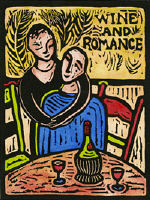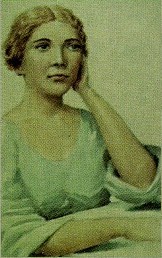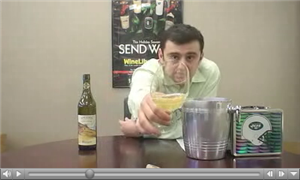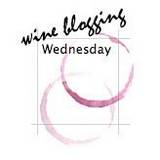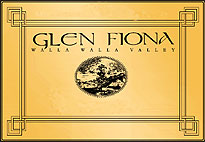
A couple of weeks ago, when I described the exhilarating pear and floral notes I tasted in a Viognier, some friends scoffed. How could I smell pears and flowers in a wine -- unless it had been made with petunias and pear juice? Did I really know what I was talking about?
What about that chocolate I taste in a Merlot? Did the winemaker dump left-over chocolate Easter bunnies into the wine barrels? Oh, and the cat-pee smell in Sauvignon Blanc? Did they wrangle cats into the winery during the Sauvignon Blanc crush? Asparagus and green olives in a Cabernet Franc? You should be making dirty martinis with olive juice, not dirty wine. Wet dog smell? Did you wash your dog in the wine? Band-aid smell? Barn yard smell?
Gout de merde! You are crazy, lady!
No, I'm not crazy. I am just a wine geek. A wine geek is a harmless person who swirls her orange juice in the morning, keeps a statue of
Thomas Jefferson (the first American Wine Geek) by the wine rack, and runs to the nearest fainting couch with smelling salts when someone claims there is no such thing as
terroir.
The facts are this: wine grapes have a tendency to pick up the flavors of the soil and elements in the surrounding environment as they grow in their vineyard. And some wine grapes naturally have chemical compounds similar to those found in the other things they might smell like -- that is, the pear notes in a Viognier come from a similar chemistry in parts of the Viognier grape and pears. Moreover, certain winemaking techniques, such as aging wines in oak barrels, add other traits that can be smelled and tasted in the finished wine. Raw fresh oak wood often has an aroma of vanilla; you'll smell vanilla, too, in certain wines aged in new oak barrels.
In 1995, Ann C. Noble, Emeritus Professor of Enology at the University of California-Davis, created the
Wine Aroma Wheel, a pie-chart-looking wheel of aromas used to describe wine. Dr. Noble's years of research focused on the investigation of sensory and chemical factors which can affect perception of flavor. I was fortunate enough to take a course on Wine Sensory Evaluation from Dr. Noble a few years back. Besides the chemical factors, she explained that memories can be triggered by certain smells. That explained to me the nose-memories of my grandmother's kitchen during pie baking when smelling an older Merlot or Sangiovese.
Now, about that cat-pee. While New Zealand Sauvignon Blanc may have notes of grapefruit and kiwi, there may also be hints of boxwood bush -- a pungent mix of asparagus, green bean and bell pepper, which, all together, can smell like cat-pee. In fact, it's a specific chemical called pyrazine that's responsible for the feline toilette notes. This compound dissipates in the sun as the fruit ripens, so if the grapes are picked when they aren't fully ripe (which is desirable for certain wines and in certain conditions), the more pungent the resulting Sauvignon Blanc will be. Pyrazines are also found in green peppers, Cabernet Sauvignon and Cabernet Franc. It is that compound that is responsible for the herbacious, green notes found in some red wines.
The older Rieslings from Germany often carry a kerosene nose that makes some wine aficionados swoon and others head for the spit bucket. These white wines with diesel or petrol-like fumes all have chemical compounds called terpenes, which are concentrated in the skins of the Riesling and Gewurztraminer grapes, especially, and can give off powerful smells of oil, gas, turpentine, citronella, and geranium. Winemakers usually try to mute these odors, but in some wines -- and wine markets -- the odors are actually desirable.
The chocolate and cocoa aromas and flavors that are often noted in red wines come from elements in Cabernet Sauvignon and Merlot grapes. Cigar or cedar box characteristics in Cabernet Sauvignon comes from natural compounds formed when Cabernet Sauvignon meets yeast and the wood in oak barrels. Even a non-smoking wine lover finds this a complex yet desirable quality in high-end red wines. Vanilla tones in red or white wines can come from the oak barrels where the natural sugars from the wood are brought forth from being charred inside.
How about that creamy mouth feel that you get from a Chardonnay? Sometimes aromas of buttered popcorn or the taste of butterscotch or custard will awake on your tongue after a sip of Chardonnay. This is caused from malolactic fermentation. MLF is a natural process by which a young wine’s malic acid (for any non-wine-geeks among you: think green apples, which are full of malic acid ) is converted into softer lactic acid (think plain yogurt). Winemakers have learned how to control this process. Some may avoid the MLF process in order to emphasize a crisp tartness in their wine, while others want the creamy, buttery layers. The byproduct that MLF produces is called diacetyl
. In fact, this compound can be found in the buttery yellow substance that is squirted on your movietime popcorn.
A fine Bordeaux might have notes of lavender if there are lavender fields surrounding the vineyard. A California wine might hint at the menthol smell of eucalyptus if the vineyard is surround by or near a grove of eucalyptus trees. In some Washington wines I smell or taste a bit of sage, which is not surprising considering how many Washington vineyards are bordered by sagebrush desert country.
This lesson in wine flavor chemistry is just the beginning. I haven't even begun to get on my soap box, speaking through my megaphone about the faulty chemical aromas found in wines. But that my non-wine-geek friends ...is another blog article.
(By the way, it is linalool that is found in Viognier. The same compound can be found in petunias and in your morning bowl of Tutti-Fruitti Loopies.)
 Ryan Raber, Tertulia Cellars' winemaker, and I were classmates a few years ago at the Viticulture and Enology Center at Walla Walla Community College. I caught up with Ryan again just as he had finished his first crush and was putting the finishing touches on a new winery. Tertulia Cellars emphasizes Cabernet Sauvignon, Syrah and Viognier.
Ryan Raber, Tertulia Cellars' winemaker, and I were classmates a few years ago at the Viticulture and Enology Center at Walla Walla Community College. I caught up with Ryan again just as he had finished his first crush and was putting the finishing touches on a new winery. Tertulia Cellars emphasizes Cabernet Sauvignon, Syrah and Viognier.

 Monday, February 19,
Monday, February 19,  Last year I was given a gift of
Last year I was given a gift of 